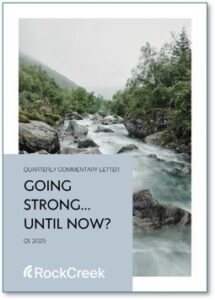Dramatic policy shifts in the US in April can make it seem like an exercise in nostalgia to look back on the first quarter of this year…
But there is value in doing so. The economic impact of the tariff and trade policy that has been a focus of market concern for much of April depends also on the state of the global economy and markets going into Q2. Changing announcements on US tariff policy have brought a level of unprecedented uncertainty. This uncertainty has slowed down, or brought to a stop, investment in new plants and IPOs. Events in Q1 will also influence the monetary policy actions of the Federal Reserve in the period ahead.
RockCreek sees three macro themes for investors to watch:
Tariffs and Trade Wars: Winners and Losers. President Trump has called tariffs a “beautiful” word. The market reaction to the White House announcement on April 2 of tariffs that were both higher and broader than expected suggested that investors see things differently. A 90-day pause on many tariffs announced on April 9 helped to calm markets. Will the trade war escalate or de-escalate? Recent comments from President Trump and his Treasury Secretary, Scott Bessent, suggest that the Administration will seek deals to bring tariffs down, including against China. But the risk of an escalating trade war is still there. Announcements about US plans and the status of talks with key trading partners suggest that policy is still in flux. This makes portfolio investor decisions more difficult. At the same time, CEOs are reluctant to decide on possible reshoring with frequent changes in rules.
Growth and Interest Rates. Will the US economy tip into recession this year, and how would the Federal Reserve react to a slowdown? The odds of recession have risen substantially as a result of tariffs and policy uncertainty. Although data for Q1 remain strong, reports abound that businesses are pausing or slowing hiring and putting investment plans on hold. The Fed’s regular survey of businesses across the US noted that in many places the outlook “worsened considerably as economic uncertainty”—mostly related to tariffs—rose. But higher tariffs will also add to prices and may spur inflation, complicating the outlook for Fed policy.
Spending and Taxes. The Republican-led Congress, supported by the White House, is moving a big bill that will raise the debt ceiling and set budget spending and taxes for fiscal 2026. The increased scale of US debt, possible reduced foreign interest in US government treasuries, and rumors of capital controls—though unlikely—have caused tremendous Treasury bond volatility. What should investors, including university endowments and foundations facing lower returns and fearful of a change in tax status, be watching for?
